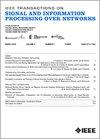Adaptive Joint Estimation of Temporal Vertex and Edge Signals
IF 3
3区 计算机科学
Q2 ENGINEERING, ELECTRICAL & ELECTRONIC
IEEE Transactions on Signal and Information Processing over Networks
Pub Date : 2025-02-14
DOI:10.1109/TSIPN.2025.3536084
引用次数: 0
Abstract
The adaptive estimation of coexisting temporal vertex (node) and edge signals on graphs is a critical task when a change in edge signals influences the temporal dynamics of the vertex signals. Existing Graph Signal Processing algorithms have extensively studied signals on graph vertices, and while recent advancements have started exploring signals on edges, a framework for systematically representing interactive time-varying signals across vertices, edges, and higher-order structures has yet to be fully realized. We propose an Adaptive Joint Vertex-Edge Estimation (AJVEE) algorithm for jointly estimating time-varying vertex and edge signals through a time-varying regression, incorporating both vertex signal filtering and edge signal filtering. Accompanying AJVEE is a newly proposed Adaptive Least Mean Square procedure based on the Hodge Laplacian (ALMS-Hodge), which is inspired by classical adaptive filters combining simplicial filtering and simplicial regression. AJVEE is able to operate jointly on the vertices and edges by merging two ALMS-Hodge specified on the vertices and edges into a unified formulation. A more generalized case extending AJVEE beyond the vertices and edges is being discussed. Experimenting on real-world traffic networks and population mobility networks, we have confirmed that our proposed AJVEE algorithm could accurately and jointly track time-varying vertex and edge signals on graphs.时间顶点和边缘信号的自适应联合估计
当边缘信号的变化影响顶点信号的时间动态时,图上同时存在的顶点(节点)和边缘信号的自适应估计是一项关键任务。现有的图信号处理算法已经广泛地研究了图顶点上的信号,虽然最近的进展已经开始探索边缘上的信号,但系统地表示跨顶点、边缘和高阶结构的交互式时变信号的框架尚未完全实现。提出了一种结合顶点信号滤波和边缘信号滤波的自适应联合顶点边缘估计(AJVEE)算法,通过时变回归对时变顶点和边缘信号进行联合估计。与AJVEE相结合的是一种基于霍奇拉普拉斯算子的自适应最小均方过程(ams -Hodge),它是受经典自适应滤波器的启发,结合了简单滤波和简单回归。AJVEE通过将顶点和边缘上指定的两个ams - hodge合并到一个统一的公式中,可以对顶点和边缘进行联合操作。讨论了将AJVEE扩展到顶点和边缘以外的更广义的情况。在现实交通网络和人口流动网络上的实验证明,我们提出的AJVEE算法可以准确地联合跟踪图上时变的顶点和边缘信号。
本文章由计算机程序翻译,如有差异,请以英文原文为准。
求助全文
约1分钟内获得全文
求助全文
来源期刊

IEEE Transactions on Signal and Information Processing over Networks
Computer Science-Computer Networks and Communications
CiteScore
5.80
自引率
12.50%
发文量
56
期刊介绍:
The IEEE Transactions on Signal and Information Processing over Networks publishes high-quality papers that extend the classical notions of processing of signals defined over vector spaces (e.g. time and space) to processing of signals and information (data) defined over networks, potentially dynamically varying. In signal processing over networks, the topology of the network may define structural relationships in the data, or may constrain processing of the data. Topics include distributed algorithms for filtering, detection, estimation, adaptation and learning, model selection, data fusion, and diffusion or evolution of information over such networks, and applications of distributed signal processing.
 求助内容:
求助内容: 应助结果提醒方式:
应助结果提醒方式:


